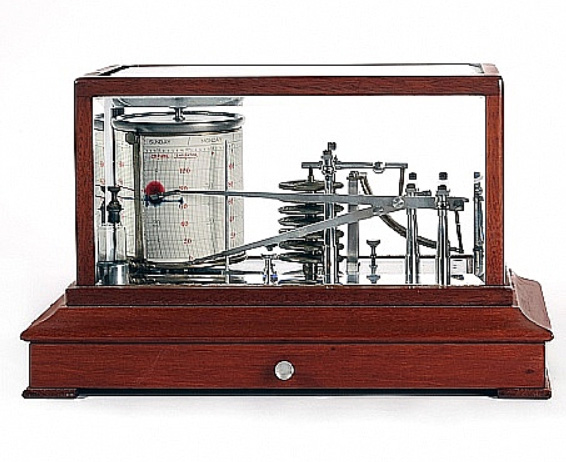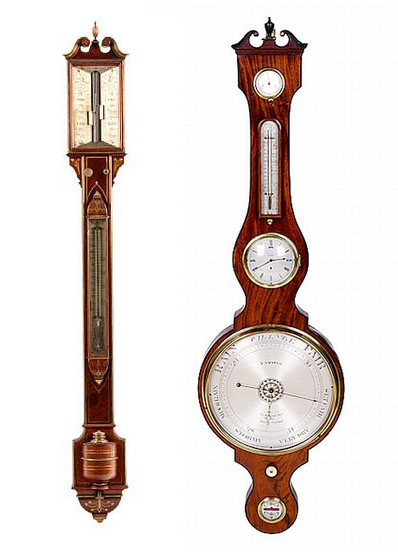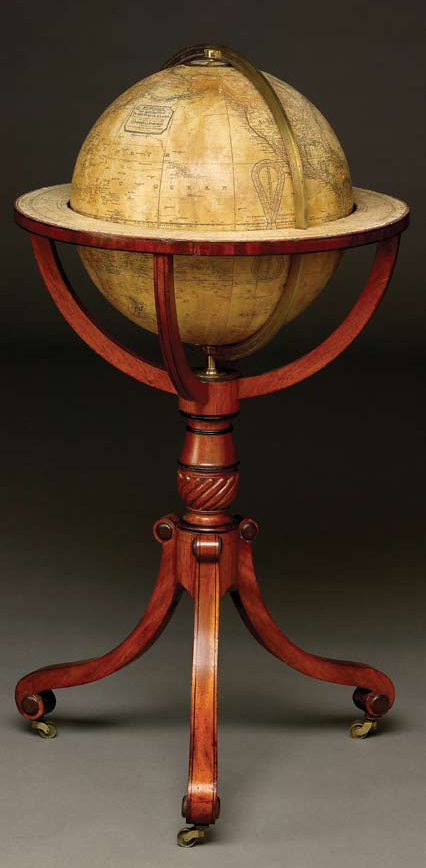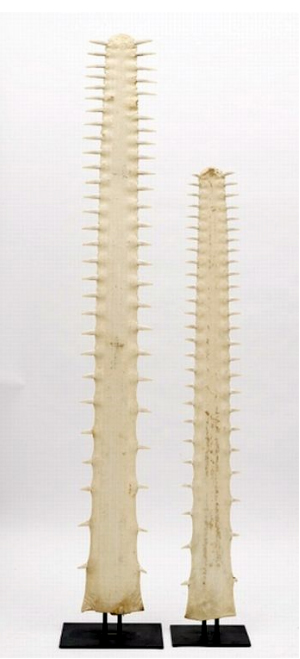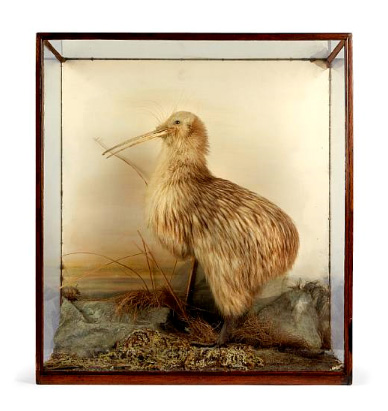Learn about antiques and collectables...
Click on a category below to show all the entries for that category.
Learn about and understand the items, manufacturers, designers and periods as well as the specialist terms used in describing antiques and collectables. Either click one of the letters below to list the items beginning with that letter, or click on a category on the left side of the screen to list the items under that category.
Barograph
The barograph, popular from the late Victorian period to the 1930s, is a variation of the aneroid barometer, and it records a graph of the atmospheric pressure over time using a pen or needle on graph paper, both of which are attached to a drum moved by clockwork. Due to the delicate nature of the mechanism they are usually housed in a five panel glass case, the base often fitted with drawers for storage of of new and used charts.
Barometer
The barometer is an instrument for measuring atmospheric pressure. The pressure indicated can aid in predicting short term weather.
There are two main types of barometer in use, the mercury barometer, which can either be in the form of a "stick" or a "wheel", and the aneroid barometer, a later invention and most commonly available.
Italian Evangelista Torricelli, an associate of Galileo, is generally credited with inventing the mercury barometer in 1643. Galileo suggested to Evangelista Torricelli that he use mercury in his vacuum experiments.
A mercury barometer has a glass tube with a height of at least 84 cm, closed at one end, with an open mercury-filled reservoir at the base. The weight of the mercury creates a vacuum in the top of the tube. Mercury in the tube adjusts until the weight of the mercury column balances the atmospheric force exerted on the reservoir.
At the time of its invention, Torricelli was not experimenting with air pressure but with the creation of vacuums, and whether or not the air had weight, and it was not until much later that it was realised the changes in air pressure measured by the barometer could be used for short term weather forecasts.
High atmospheric pressure places more force on the reservoir, forcing mercury higher in the column. Low pressure allows the mercury to drop to a lower level in the column by lowering the force placed on the reservoir.
The long tube used by Torricelli meant that the barometer was in the form of a long stick, and gave rise to the expression of atmospheric pressure in inches or millimeters or feet.
In 1665, Englishman Robert Hooke created the wheel barometer which added a circular scale and dial assembly to the mercury barometer.
In 1843, the French scientist Lucien Vidie invented the aneroid barometer, which uses a small, flexible metal box called an aneroid cell to measure changes in atmospheric pressure. Small changes in external air pressure cause the cell to expand or contract. This expansion and contraction drives a mechanism so that the tiny movements of the capsule are amplified and displayed on the face of the aneroid barometer.
The empty box is prevented from collapsing by a strong spring. Aneroid means fluidless, no liquids are used, the metal cell is usually made of phosphor bronze or beryllium copper.
Today's barometers use electronic sensors instead of mercury and metal aneroid cells.
Mercury barometers are no longer manufactured due to the recognition of the harmful effects of mercury, although old mercury barometers an still be refilled. Use of mercury in manufacturing was banned in most western countries in the 1990s or early 2000s. However mercury barometers emit zero or negligible amounts of mercury vapour, and owning one is no threat to your health. In 2006 the European Union excluded barometers from a ban on the use of mercury in manufacture or repair.
The mercury barometer makers were at their peak from about 1830 to 1890. England, due to it's robust economy and lust for science, was the home to most of these makers, though many were also found in France, Germany, Holland, Ireland, Scotland, Belgium, Portugal, and here in America.
There were a number of famous makers based in London, such as Negretti & Zambra, Troughton & Simms, Comitti and Son, and Dolland & Co. and some barometers were made and stamped with the name of the upmarket retailer through whose premises they were sold. Nicholas Goodison in his book English Barometers 1680 - 1860 Antique Collectors Club, 1977, lists almost 2000 makers and retailers of barometers during this period.
Mercury barometers were precision scientific instruments and would have only been owned by the very wealthy. This is reflected by the use of exotic timbers such as rosewood, mahogany and walnut, and the craftsmanship entailed in their manufacture.
The Admiral Fitzroy Barometer is a style of mercury barometer based on work by Admiral Fitzroy in the late 1850's.
Admiral Robert Fitzroy achieved lasting fame as the captain of HMS Beagle during Charles Darwin's famous voyage, and in his position as Meteorological Statist to the Board of Trade in 1854, as a pioneering meteorologist who made accurate weather forecasting a reality.
The Admiral Fitzroy Barometer usually consists of a mercurial barometer (open tube type), thermometer, printed instructions and a storm glass or storm bottle, the latter contains a mixture of chemicals which change their appearance depending on the type of approaching weather.
Aneroid barometers measure the air pressure by means of a vacuum chamber with flexible side. Any change in the air pressure alters the thickness of the chamber, and the movement is measured and linked to an indicator needle through levers and pulleys. They were popular in the mid to late Victorian and Edwardian period, and saw the barometer move from an instrument that could only be owned by the very wealthy to become an affordable aspiration by the rising middle classes.
Carboy / Carboys
A carboy is a type of container, typically made of glass or plastic, that is used for holding and transporting large quantities of liquids, such as water, chemicals, or fermented beverages. The name "carboy" comes from the Persian word "qarabah," which means "large jug."
Carboys have been in use for centuries, dating back at least to medieval times. They were originally made of glass and were used to transport and store wine, beer, and other fermented beverages. They were also used for transporting and storing water and other liquids, particularly in the chemical industry. They may can be fitted with a variety of different closures, such as screw caps, snap-on lids, or pour spouts, depending on their intended use.
Celestial and Terrestrial Globes
A celestial globe is a revolving globe which displays the stars, planets and other heavenly bodies. It is an imaginary sphere of gigantic radius, with the earth at its centre. A terestial globe is a spherical model of the Earth that maps out the various continents and oceans.
Celestial globes have been made for more than two thousand years. However interesting terrestrial globes could not be made until it was established that the world was round. Production of globes from about 1500 was simplified by the use of gores, pieces of paper of a special shape, which were printed and glued to a sphere, often of papier mache. From the eighteenth century a pair of globes, handsomely mounted, was an essential for every gentleman's library. Pocket globes were very popular in the eighteenth century.
Equinoctial Dial on a Sundial
An equinoctial dial is a type of sundial that uses the equator as a reference plane and the gnomon, or sundial arm, is positioned perpendicular to the equator, which allows the sundial to be used in any location with a clear view of the sun and provides an accurate reading of local solar time.
Equinoctial dials were first developed in ancient Greece and were later refined by Arab astronomers. The dials became popular in Europe during the Renaissance, when they were used as both scientific instruments and works of art. Equinoctial dials were particularly popular in Italy, where they were often made of bronze or stone and were decorated with intricate engravings, sculptures, and inscriptions. The sundial as an instrument was superseded by the chronometer.
Gimbal
On a ship, a gimbal is a pivoted mounting for the compass, clock, chronometer, stoves, drink holders and other equipment which keeps the item horizontal, no matter which way the vessel is leaning.
Newton & Son
The firm Newton & Son began its history in 1780, when founder John Newton published a reissue of a Nathauriel Hill pocket globe.
The firm grew rapidly after Newton's second son William joined forces with his father, and by 1831 Milred Berry became a partner.
By 1841, ownership passed to William's eldest son, William Edward. Such was the success of the firm that it continued in operation by subsequent generations until the early part of the twentieth century.
Rostrum
The rostrum is the name given to the saw-like nose extension found on swordfish and sawfish.
The body and head of the fish, like the rostrum, are flat and the fish spends much of its time lying on its stomach on the ocean floor. The fish uses the rostrum to slash at their prey, wounding it and allowing the predator to devour it.
Recent sales in Australia have included some rostrum of over 150 cm in length, but most coming onto the market are 40 - 50 cm.
Rowland Ward
The most famous taxidemist of the late Victorian era, Rowland Ward was born in London in 1847, and left school at 14 to work at his father Henry Ward’s taxidermy studio.
Around 1872 he established his own business in Harley Street London, and after a few years in premises in Picadilly, which he named "The Jungle". He became the taxidermist to big game hunters and for many years in the late 19th century and early 20th century was the largest and most famous taxidermist in the world.
He died in 1912 and the business continued until 1983.
Such is the esteem with which his work is held, any taxidermy coming onto the market bearing his name or intitials on a paper label or plate will command a premium.
Taxidermy
Taxidermy is the art of mounting or reproducing animals for display or study and in the past the word has been associated with large gloomy Victorian houses filled with stuffed animals.
However in recent years, taxidermy has emerged from the shadows as a collecting area in its own right and in the United Kingdom there are now dealers who deal only in taxidermy. In Victorian times, taxidermists performed a valuable service, bringing wildlife into homes and allowing the inhabitants to see real birds and mammals at close quarters. They could also create trophies to provide mementoes of a good day's fishing or hunting.
The value of taxidermy specimens is enhanced by the presence of an original label detailing when and where the specimen was obtained and by a trade label of the taxidermist, the most sought after being Rowland Ward of London.
In assessing a taxidermied specimen, the potential buyer should carefully study the colours and brightness of the specimen, the eyes, the detail of the groundwork, style and condition of the case and the rarity of the species. Worm or insect eaten specimens, fading, and other damage substantially reduce the value of taxidermied items.
